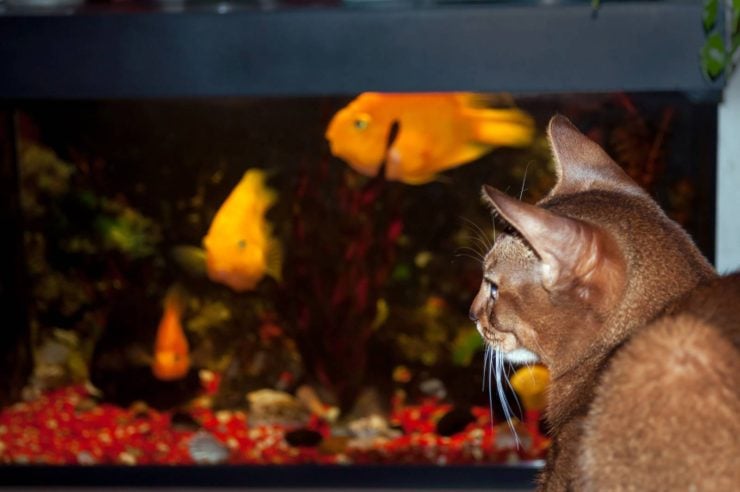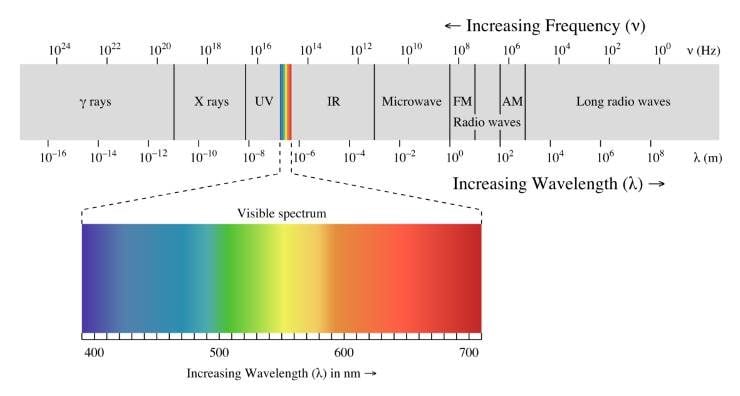Our cats love to gaze at the colorful fish tanks in our house and office. They paw at their finned friends passing by. That begs the question, are cats color blind ? Are they able to appreciate the beauty? Common speculation is that cats, like most animals, are color blind. This is only partially true, and you’ll see why.
In this article, you’ll learn what colors cats like, are cats color blind, and why cats eyes evolved this way.

Table of Contents
- Are cats color blind?
- What colors do cats see?
- What colors do cats like?
- Do we perceive colors differently?
- Cats can detect light beyond blue, unlike humans
- Color vision isn’t important to cats
Are cats color blind?
Yes. Cats are color blind if we use the definition of a colorblind person. However, cats do see color. They are able to tell the difference between red, yellow, and blue as well as red and green colors. Cats may also be able to see ultra-violet light. But cats don’t see vibrant colors like we can. While their range of color recognition is less than ours, they have better night vision than we do. More on this below.
What colors do cats see?
The myth that cats see only black and white, was busted long ago. We’re sure that as a loving cat owner you already knew that.
The assumption that cats are color blind arose from experiments in the early 20th century. Cats were unable to guess in which of the colored bowls a fish was located. That experiment, however, did not take into account that it’s hard to train cats to do anything.
The physiology of eyes dictates that there must be a tradeoff between color vision and ability to see in dim light conditions. Our eyes and the eyes of our feline friends contain photo-sensitive cells. These photoreceptor cells that convert light into signals to our brain into are called rods and cones.
Rod cells let animals discern slight movement better in the dark. Cones allow for better differentiation of colors. Cats have two types of cones that let them see blue-violet and yellow-green wavelengths of light, but not red-orange. This is considered dichromatic vision or the ability to see only 2 colors. We have three types of cones which means your cats vision will see muted tones of pastel shades rather than the bright colors we see. We know that feline vision has more rods and less cones than human vision.
Later experiments revealed that even though it takes a high number of trials, cats can be trained to distinguish between red and green lights as well as yellow, blue, and red lights.
Additionally, the researchers discovered that cats have different cones responding to the long, middle, and short wavelengths of light. Those are blue, green, and red, respectively. The discovery raises the possibility that cats are photopic trichromats like us. This means they are able to distinguish three colors. Though likely not as good as we do. So if you are thinking that you should buy a color tv to help entertain your cat while you are at work, it’s not a bad idea. Your cat can enjoy it. Ours enjoy watching tv with us at times. But scary monsters may turn them off to it like it did one of our cats.
What colors do cats like?
When shopping for your cats next toy, consider that their favorite colors are blue and yellow. This is because your cats vision has evolved to discern these. Also something that moves will be of interest to them because of their amazing ability to discern the slightest movements due to the high number of rods in their eyes. Which is why cats can see much better in dim light than we can.
While your cat can’t tell you they have a favorite color, you’ll notice they’ll respond to something the color green or the color blue better than orange as they can discern blue-green but less so red-orange. But what about those red laser pointers that cats love? We believe it’s less about it not being their favorite color, but the movement and brightness is what attracts your cats attention. When the laser pointer dot is far away, you may notice your cat seems to ignore it. That may be because their peripheral vision and depth perception aren’t as good as ours, but they can see way better in dim lighting than we can.
So look for color combinations with your cat vision goggles on. This means match the color of their toys to the color cones they have which are blue and yellow. Brighter colors are better even though they can’t see them as well as we do. This should help the toy stand out better for your cat. Especially if it moves.
Do we perceive colors differently?
At the same time, we still can’t and likely won’t soon, draw a precise picture of how your cats vision allows them to view the world. Many scientists and artists have done it, but you have to understand that those are only hypothesis, although some are more educated than others.
Color perception is subjective. In fact, we can’t even tell if all humans see colors equally, because we can’t describe colors. Human vision technically can’t tell what green looks like, we can only compare it to something that is agreed to be the color green.
We know that our furry friends see colors. But their ability to differentiate close shades is limited, especially for reddish colors.
You could say that to a cat, orange and red appear more similar than blue and violet even though their spectrum of colors are similar.
The thing is, a cat’s ability to see light does not stop at violet wavelengths as it does for us. That’s where their wider range of color vision is superior to ours.
Cats can detect light beyond blue, unlike humans
A study, scientists examined the eyes of many mammals, including cats. They discovered that cats’ eyes detect ultraviolet light, which is invisible to us.
It’s ironic, but given this information, cats could argue that we humans are color blind as we are unable to see all the colors they can see.
But what does it actually mean that cats have UV vision? Does it serve a specific purpose? We’d love to think so because Superman has the same ability, but physics says it shouldn’t.
Ultraviolet light isn’t much different from any other lights. Besides the fact we can’t see it. At the same time, we can’t see plenty of other “lights” either.

UV vision is just an extension of the visible spectrum. This allows cats to see a broader range of the color spectrum. It might allow cats to notice things differently, such as detecting urine marks not only with their nose but visually as well. However, that is only a speculation.
Note that the research mentioned above does not use the term “UV vision.” It says “ultraviolet sensitivity,” because scientists can claim only things they know for sure. They know that cats’ eyes are sensitive to UV light, but that does not necessarily mean cats can see it.
Even if cats can see their prey’s paw print trail because of ultraviolet vision, we should not consider it a superpower of some sort. If that were the case, the ability to see red berries in a green bush would be a superpower too.
Now we are stepping onto the thin ice of philosophy. Maybe seeing anything should be considered a superpower because not all animals have eyes. Besides, we can continue to argue about who really is color blind. Cats who can see the UV part of the spectrum or humans who can see red more clearly?
Color vision isn’t important to cats
The consensus is that cats do see color. Not the bright colors as we do, but the assumption that cats are like color blind people is directionally correct. That said, the ability to distinguish between colors is not of much use for cats.
Evolution has tailored their eyes for a specific purpose, which is hunting mice. Mice and other rodents are nocturnal. This means cats have evolved to hunt effectively at dusk and dawn. Without the sun light, these aren’t the most colorful times of the day. Under such conditions, perfect color vision was traded for something more useful, cats ability to detect movements and see in the dark much better than we can. Cats eyes evolved to best be able to see their prey in the dark. This is one of the reasons your cat is such an effective hunter.
You’ve learned what colors cats like, are cats color blind, and why cats eyes evolved this way. While your four legged fur ball can see way more than shades of gray, they can’t see the wide range of colors as we do. That said, their eyesight serves them well for hunting down that elusive bowl of food bowls with deadly precision.
